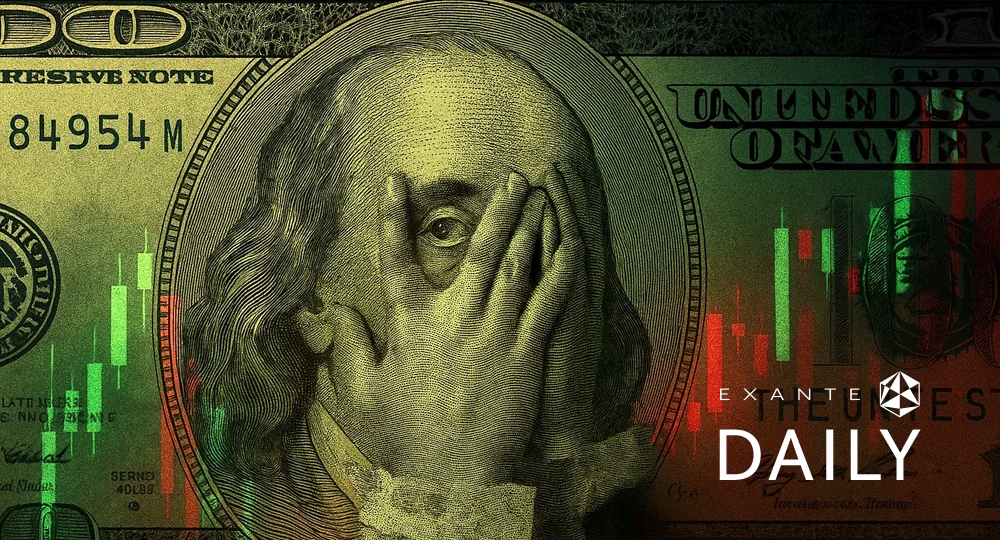
Are earning expectations more important than actual performance?

Corporate Earnings News
Global market indices
Currencies
Cryptocurrencies
Fixed Income
Commodity sector news
Key data to move markets this week
Global macro updates
Corporate Earnings News
Corporate earning calendar 25 April - 2 May 2024
Thursday: Alphabet, Bristol-Myers Squibb, Caterpillar, Keurig Dr Pepper, Newmont, Merck & Co., Willis Towers Watson, Gilead Sciences, Intel, Snap Inc.
Friday: Abbvie, Aon, Ball Corp, Chevron, Exxon Mobil, Yara International
Monday: MicroStrategy
Tuesday: Amazon, 3M Co, Coca-Cola, Eli Lilly & Co, McDonald's Corp., Starbucks, PayPal Holdings, Mondelez, Lemonade, Advanced Micro Devices, Pinterest
Wednesday: Automatic Data Processing (ADP), Barrick Gold, Estee Lauder Companies, Kraft Heinz, Mastercard, Etsy, Pfizer, Qualcomm
Thursday: Apple, Mosaic, Albemarle, Amgen, Moderna, Novo Nordisk, Cloudflare, Coinbase Global, Illumina, Unity Software, Shopify
US Stock Indices Price Performance
Nasdaq 100 -3.99% MTD +4.17% YTD
Dow Jones Industrial Average -3.38% MTD +2.05% YTD
NYSE -3.03% MTD +5.37% YTD
S&P 500 -3.48% MTD +6.33% YTD
The S&P 500 climbed +0.98% over the past week, as earnings season is now fully underway. The overall earnings picture continues to reflect a narrative of steady, reasonably strong growth.
US stocks rebounded in recent sessions after notching their worst week in more than a year. This recovery was fueled by a string of earnings reports from companies like Visa and Texas Instruments. However, some of the initial market enthusiasm waned on Wednesday when investors began to dissect earnings reports from members of the Magnificent Seven.

This week investors have pulled some $200 million out of value based exchange-traded funds, according to data compiled by Bloomberg Intelligence. In contrast, growth stocks have attracted more than $3 billion in inflows — despite a shaky stock market that’s raised concerns of more downside to come.
US stocks
Mega caps: A mixed week for the “magnificent seven” as investors waver on their support. Microsoft -0.68%, Alphabet +2.35%, Amazon -2.58%, Meta Platforms -0.13%, Nvidia -5.19%, Tesla +4.30%, and Apple +0.60%.
Meta posts record quarter but fails to convince investors it’ll make AI a reality. Meta Platforms delivered a record-breaking first quarter, boasting a 27% year-over-year increase in revenue to $36.5 billion. This growth is attributed to advancements in artificial intelligence (AI) that have bolstered ad-targeting capabilities. These advancements helped Meta overcome privacy changes implemented by Apple, which previously hampered revenue. Over the past nine months, their revenue growth has outpaced that of its major tech competitors, matching the pandemic-fueled heights of Apple, Microsoft, Google, and Amazon. This quarter's growth marks the third consecutive period exceeding 20% year-over-year increases.
However, investor enthusiasm for Meta's AI vision was tempered by forecasts of rising costs. The company announced plans to increase annual spending by up to $10 billion to support infrastructure for its AI initiatives. This news triggered an initial stock price drop of over 15%.
To support its AI ambitions, Meta revised its capital expenditure projections for 2024 to a range of $35 billion to $40 billion, up from a previous estimate of $30 billion to $37 billion. The company anticipates continued increases in capital expenditures in 2025 as well.
Furthermore, Meta's second-quarter revenue forecast of $36.5 billion to $39 billion fell short of analyst expectations, overshadowing the positive first-quarter performance.
Shareholders, while excited about the long-term potential of AI, are also wary of the significant upfront investments required. Building and deploying AI models necessitates substantial computing power, pushing companies like Meta to invest heavily in servers and cutting-edge AI chips.
Musk buys Tesla some time promising to put the ‘auto’ in automobile. In a bid to address Wall Street's concerns, Tesla CEO Elon Musk outlined a renewed focus on producing more affordable electric vehicles during the company's earnings call. Tesla had a challenging first quarter marked by a significant decline in profits to their lowest level since 2021. Tesla's operating margin also narrowed substantially, dropping from 11.4% to 5.5% year-over-year.
Musk emphasised Tesla’s commitment to achieving its long-held goal of developing a fully autonomous car. He unveiled details regarding a dedicated robotaxi model and a corresponding ride-hailing network. This service, likened to Airbnb by Musk, would involve Tesla operating its own fleet alongside allowing customer participation. He even playfully hinted at a potential name for the robotaxi – the "Cybercab" – scheduled for reveal on 8th August.
However, Tesla faces a number of headwinds including softening demand and price pressures. Additionally, the company's free cash flow turned negative in Q1, with a net loss of approximately $2.5 billion due to investments in AI infrastructure. Unsold vehicle inventory also climbed to a 28-day supply, compared to 15 days in the previous year.
This call marked Musk's first official interaction with investors after initiating a restructuring plan anticipated to reduce Tesla's global workforce by over 10%. Despite the overall negative outlook, Tesla's stock price surged over 10% in after-hours trading following the earnings report, albeit remaining down 42% for 2024 as of Tuesday's closing price.
Energy stocks had a generally good week as the energy sector itself is +1.94% MTD. Energy companies were generally up with Occidental Petroleum +2.04%, Shell +2.19%, ConocoPhillips +0.74%, Chevron +4.58%, Baker Hughes +2.03%, Halliburton +1.79%, ExxonMobil +2.04%, and Phillips 66 +0.34%. Apa Corp (US) -0.65%, and Marathon Petroleum -1.64%.
Materials and Mining stocks had a slightly negative week although copper and aluminium prices both climbed this week, +1.99% and +0.62%, respectively, while gold is -2.61%. Nucor -10.38%, Yara International -3.50%, Freeport-McMoRan -3.17%, and Sibanye Stillwater -10.0%. Mosaic +0.66%, CF Industries +1.86%, Newmont Mining +0.10%, and Albemarle +0.76%.
Mosaic has scheduled its Q2 earnings call for 2nd May.
Yara International has scheduled its Q2 earnings call for 26th April.
Albemarle has scheduled its Q2 earnings call for 2nd May.
European Stock Indices Price Performance
Stoxx 600 -1.38% MTD +5.56% YTD
DAX -2.18% MTD +7.98% YTD
CAC 40 -1.39% MTD +7.27% YTD
IBEX 35 -0.42% MTD +8.31% YTD
FTSE MIB -1.38% MTD +12.3% YTD
FTSE 100 -4.43% MTD +3.97% YTD
The pan-European STOXX Europe 600 index closed the week ending 24h April, 2024 +1.4%.
Traders are weighing an influx of corporate earnings reports this week while simultaneously growing more cautious about the number and timing of interest rate cuts expected from the European Central Bank and Bank of England.
According to LSEG I/B/E/S data, first quarter earnings are expected to decrease 12.1% from Q1 2023. Excluding the Energy sector, earnings are expected to decrease 8.7%. First quarter revenue is expected to decrease 5.0% from Q1 2023. Excluding the Energy sector, revenues are expected to decrease 5.1%. 34 companies in the STOXX 600 have reported earnings as of 23 April for Q1 2024. Of these, 61.8% reported results exceeding analyst estimates. In a typical quarter 54% beat analyst EPS estimates. 38 companies in the STOXX 600 have reported revenue as of 23 April for Q1 2024. Of these, 50.0% reported revenue exceeding analyst estimates. In a typical quarter 58% beat analyst revenue estimates.
During the week of 29 April, 57 companies are expected to report quarterly earnings.
Other Global Stock Indices Price Performance
MSCI World Index -3.12% MTD +4.30% YTD
Hang Seng +4.56% MTD +1.46% YTD
The Hang Seng Index is up almost +6% this week and is set for its best performance since December 2022. As noted by Bloomberg news, mainland investors have bought stocks on a net basis for 19 straight sessions via the trading links with Hong Kong. The MSCI World Index is +1.3% over the past week.
Currencies
EUR -0.84% MTD -3.08% YTD to $1.0701.
GBP -1.32% MTD -2.15% YTD to $1.2464.
The Dollar Index closed the week little changed at 105.857 and maintains a YTD gain of approximately +4.46%.
This week the euro was +0.62% against the USD despite eurozone business activity expanding at its fastest pace in nearly a year in April and Germany's private sector unexpectedly returning to growth. The British Pound was +0.23% this week after falling last week when BoE Governor Andrew Bailey said that inflation was broadly declining in line with BoE forecasts, indicating that interest rates might fall more quickly than the market currently expects. However, Sterling jumped against the dollar on Tuesday on stronger business activity data and comments from BoE Chief Economist Huw Pill that rate cuts remained some way off.
Cryptocurrencies
Bitcoin -8.10% MTD +52.65% YTD to $63,938.36
Ethereum -10.49% MTD +36.98% YTD to $3,133.35
The fourth quadrennial halving for Bitcoin took place in the early hours of 20 April resulting in a 50% drop in the digital asset’s supply growth rate. Over the course of the month Bitcoin has been affected by the rise in global geopolitical risks, which have pushed investors towards safe haven assets. It’s also been hit by rising expectations that the Fed will delay its first interest rate cut until the end of Q3, with a growing possibility of it not cutting until after the US election in November. There has also been speculation about whether Bitcoin in particular would immediately benefit from the halving despite previous halving not seeing any real impact on prices until 50 to 100 days after the event. It appears that investors may still be gauging the macroeconomic variables as volatility in the market has declined in the initial days post halving.
Note: As of 6:45pm EDT 24 April 2024
Fixed Income
US 10-year yield +34 basis points MTD +77 basis points YTD to 4.65%
German 10-year yield +19 basis points MTD +57 basis points YTD to 2.59%.
UK 10-year yield +25 basis points MTD +81 basis points YTD to 4.33%.
US bonds fell again this week as traders await advanced Q1 GDP on Thursday and the personal consumption expenditures (PCE) on Friday for further clues on Federal Reserve policy. The US Treasury saw solid demand for an auction of five-year notes on Wednesday.
Markets are now pricing in a total of 43 basis points of easing this year. This is well below the 160 basis points in cuts expected in January. The first rate cut is expected to come in September although there are increasing bets that the first cut may not come until November.
Following a robust demand for the two-year note auction on Tuesday, investors on Wednesday digested a $70 billion sale of five-year Treasuries at a yield that was slightly higher than expected. This issuance continues a trend of strong investor appetite for US government debt. However, with the upcoming Treasury quarterly refunding announcement and the Federal Reserve meeting scheduled next week, investor receptiveness for longer-dated securities, like the $44 billion issuance of seven-year notes planned for Thursday, may be more cautious.
Italian bond yields, a benchmark for the eurozone periphery, also experienced a rise of +8 basis points, reaching 3.98%. The spread between Italian and German 10-year yields widened +3 basis points to from 140.4 last week.
Eurozone bond yields were up this week on stronger economic data and in tandem with US yields. Eurozone benchmark German 10-year yield rose +12 basis points this week. Eurozone government bond yields climbed on Wednesday as markets reacted to surprisingly strong business activity data. This data suggests the economic situation might be more robust than anticipated, potentially reducing pressure on the ECB to extend interest rate cuts beyond June.
While the ECB signalled a rate cut in June, policymakers remain divided on the future trajectory. Bundesbank President Joachim Nagel, a key figure within the ECB, cautioned that inflation could prove persistent, and the June cut might not be followed by further reductions.
Benchmark 10-year UK government bond yields (gilts) surged to their highest level since November this week, exceeding 4.36% during trading. Similarly, 30-year yields spiked, reaching 4.82% after a new issuance of £6.75 billion ($8.39 billion) of 30-year debt by the UK Debt Management Office.
This market shift suggests investors are increasingly doubtful about the BoE's commitment to multiple rate cuts. While there's still an over 50% chance of a cut in August, futures markets now price in only one cut by the end of the year, down from earlier expectations of two. This aligns with comments from BoE Chief Economist Huw Pill, who suggested on Tuesday that a rate cut might be closer than initially thought, but not immediate.
Commodities
Gold spot +3.84% MTD +12.23% YTD to $2,319.55 per ounce.
Silver spot +8.62% MTD +13.94% YTD to $27.12 per ounce.
West Texas Intermediate crude -0.32% MTD +15.73% YTD to $82.89 a barrel.
Brent crude +0.74% MTD +14.43% YTD to $88.12 a barrel.
Gold prices were -2.61% this week due to an increasingly strong US dollar and rising yields.
Oil prices witnessed a slight increase throughout the week ending 24th April. The West Texas Intermediate (WTI) and Brent crude benchmarks closed the week higher by +0.24% and +1.21%, respectively.
The recent retreat in oil prices, even after surpassing $90 a barrel, reflects a recalibration of market priorities. While geopolitical tensions remain, concerns about the global economic slowdown are now taking centre stage.
Several key factors will likely shape oil prices this quarter. Production cuts by major producers could restrict supply, potentially pushing prices higher. Economic data releases from China and the eurozone will be scrutinised for signs of growth or contraction, which can significantly impact energy demand. Finally, as the Northern Hemisphere transitions into summer, an anticipated tightening of supply could coincide with increased demand, potentially influencing the price trajectory.
Note: As of 4 pm EST 24 April 2024
Key data to move markets this week
EUROPE
Thursday: German Gfk Consumer Confidence and ECB Economic Bulletin.
Friday: A speech by ECB Vice President Luis de Guindos.
Monday: Spanish Harmonised Index of Consumer Prices, Eurozone Business Climate, Consumer Confidence and Economic Sentiment surveys, and German CPI and Harmonised Index of Consumer Prices.
Tuesday: French GDP, German Retail Sales, Spanish GDP, German GDP, German Unemployment Rate, German Unemployment Change, Italian GDP, Eurozone Harmonised Index of Consumer Prices, and Eurozone GDP. European Markets closed on Labour day.
UK
Thursday: Gfk Consumer Confidence.
Wednesday: S&P Global/CIPS Manufacturing PMI.
Thursday: German HCOB Manufacturing PMI and Eurozone HCOB Manufacturing PMI.
US
Thursday: GDP, Personal Consumption Expenditure Prices, Core Personal Consumption Expenditures, Initial and Continuing Jobless Claims, and Pending Home Sales.
Friday: Core Personal Consumption Expenditures - Price Index, Personal Consumption Expenditures - Price Index, Personal Income, Personal Spending, University of Michigan Sentiment Index, and UoM 5-year Consumer Inflation Expectations.
Tuesday: Employment Cost, Housing Price Index, Chicago Purchasing Managers’ Index, and Consumer Confidence.
Wednesday: ADP Employment Change, S&P Global Manufacturing PMI, ISM Manufacturing Employment, ISM Manufacturing New Orders, ISM Manufacturing PMI, ISM Manufacturing Prices Paid, JOLTS Job Opening, Fed Interest Rate Decision and Monetary Policy Statement.
Thursday: Initial and Continuing Jobless Claims, Challenger Job Cuts, Nonfarm Productivity, Unit Labour Costs, and Factory Orders.
JAPAN
Thursday: Tokyo CPI.
Friday: BoJ Interest Rate Decision.
Monday: Unemployment Rate and Large Retail Sales.
Wednesday: BoJ Monetary Policy Meeting Minutes.
CHINA
Tuesday: NBS Manufacturing and non-manufacturing PMIs.
Global Macro Updates
The complex relationship of the US economy and the Fed. The Fed is due to meet next Tuesday and Wednesday. The market expects the Fed to maintain rates but will be looking closely at the language used to determine if there will be one, two or even any interest rate cuts this year.
The Fed has, to a certain extent, been a victim of its own success. The US economy has not, thus far, derailed. There has been signs of a slight slowdown in growth with some weakening in the flash Composite PMI for April and new orders for key US - manufactured capital goods rising moderately by only 0.2% in March with data for the prior month revised lower.
However, the advance estimate of gross domestic product for the January-March quarter, due today, is expected to show another quarter of strong performance, with a Reuters poll of analysts suggesting that GDP increased at a 2.4% annualised rate last quarter. The economy grew at a 3.4% pace in the October-December quarter. Last week, the IMF upgraded its 2024 forecast for US growth to 2.7% from the 2.1% projected in January. The continuing growth will be due to a still tight labour market that is driving consumer spending. This spending accounts for more than two-thirds of economic activity in the US. Markets will also be looking to Friday’s Core PCE, the Fed’s favourite inflation gauge. This will likely put the Fed on course to delay rate cuts although, with lower-income households having depleted their pandemic savings and now largely relying on debt to fund purchases, the economy may still turn further downwards, with wages falling later in the year, giving the Fed the headroom to make rate cuts.
BoJ faces a tightening policy conundrum. Japan’s yen weakened 0.3% to ¥155.32 on Wednesday as US stocks edged slightly higher. By Thursday morning in Asian trading it hit a fresh 34-year low versus the dollar of 155.74 and a 16-year low against the euro of 166.98. Despite suggestions of intervention and mounting pressure on the BoJ to tighten monetary policy further, investors are now expecting a Bank of Japan policy meeting that ends on Friday not be hawkish enough to support the Japanese currency. However, analysts expect the BoJ to revise its core inflation outlook for fiscal 2025. The focus will be on whether Ueda adopts a hawkish stance regarding future rate increases.
The BoJ's decision-making calculus has been complicated by the US Fed narrative. Fed Chair Jay Powell has signalled the likelihood of prolonged high interest rates to combat inflation. Spot markets have suggested that this may potentially lead to further tightening by the Fed. This prospect of Japanese rates staying low for an extended period and expectations for a delayed start to US rate cuts have continued to push down the yen. This has prompted an unusually candid warning from BoJ Governor Kazuo Ueda. He cautioned that the central bank may be forced to act if the negative impacts of the weaker yen become "excessively pronounced."
This follows Ueda's moves to unwind years of unconventional BoJ policies, culminating in the departure from negative interest rates just last month. He indicated at the time that any further increases in borrowing costs would be gradual to avoid disrupting global markets.
However, the yen's depreciation is stoking inflationary pressures by increasing the cost of imported goods. Core inflation, excluding volatile food prices, climbed to 2.6% Y/o/Y in March. Analysts warn that persistent inflation exceeding the BoJ's 2% target could compel Ueda to implement a faster-than-anticipated pace of rate hikes. This scenario is particularly concerning for Japanese officials as it could trigger a spike in government bond yields and abrupt shifts in investment flows.
Market expectations, as reflected in two-year forwards on the overnight index swap rate (a key benchmark for monetary policy expectations), now anticipate the BoJ's policy rate to surpass 0.6% from its current near-zero level, aligning with the revised Fed expectations. Previously, many Japanese investors believed the BoJ's policy rate would not rise above 0.5% despite the end of negative rates.
Following the March meeting, initial forecasts placed the next BoJ rate increase in September. However, markets now anticipate a July adjustment, implying the potential for the BoJ to raise borrowing costs twice more in 2024. With interest rates currently at zero and inflation at 2%, concerns about the potential for inflation to solidify and even rise above target are escalating. The weaker yen is helping to fuel inflation. With the yen continuing to hit multi-decade lows, it encourages speculative flows. In addition, wage data has been signalling rising inflationary pressures with wage hikes at larger companies topping 5% and smaller and midsize manufacturers seeing wage increases averaging 4.12% this year.
Guiding the exchange rate is not part of the BoJ's official mandate, and central bankers have historically been hesitant to address weakness in the yen. However, the recent depreciation is largely driven by the widening interest rate gap between Japan and the US.
Finance Minister Shunichi Suzuki issued a strong verbal warning on Tuesday, stating that "the groundwork has been laid" for Tokyo to take "appropriate action" in the currency market. This coincides with a rare joint statement by the US, Japan, and South Korea expressing "serious concerns" about the depreciation of the yen and won.
While every effort has been made to verify the accuracy of this information, EXT Ltd. (hereafter known as “EXANTE”) cannot accept any responsibility or liability for reliance by any person on this publication or any of the information, opinions, or conclusions contained in this publication. The findings and views expressed in this publication do not necessarily reflect the views of EXANTE. Any action taken upon the information contained in this publication is strictly at your own risk. EXANTE will not be liable for any loss or damage in connection with this publication.
This article is provided to you for informational purposes only and should not be regarded as an offer or solicitation of an offer to buy or sell any investments or related services that may be referenced here. Trading financial instruments involves significant risk of loss and may not be suitable for all investors. Past performance is not a reliable indicator of future performance.




